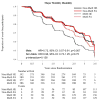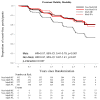Effect of Metabolic Syndrome on the Mobility Benefit of a Structured Physical Activity Intervention-The Lifestyle Interventions and Independence for Elders Randomized Clinical Trial
- PMID: 28369670
- PMCID: PMC5478451
- DOI: 10.1111/jgs.14793
Effect of Metabolic Syndrome on the Mobility Benefit of a Structured Physical Activity Intervention-The Lifestyle Interventions and Independence for Elders Randomized Clinical Trial
Abstract
Objectives: To test whether structured physical activity (PA) is associated with a greater reduction in major mobility disability (MMD) in older persons with metabolic syndrome (MetS) than in those without.
Design: Data from the Lifestyle Interventions and Independence for Elders (LIFE) Study, a multicenter randomized trial of 1,635 persons with assessments every 6 months (average 2.7 years).
Setting: Eight U.S. centers.
Participants: Sedentary men and women aged 70 to 89 with functional limitations (N = 1,535); 100 participants were excluded because of missing MetS data.
Intervention: Participants were randomized to a moderate-intensity PA program (n = 766) or a health education program (n = 769).
Measurements: MetS was defined according to the 2009 multiagency harmonized criteria. Outcomes included incident MMD (loss of ability to walk 400 m) and persistent MMD (two consecutive MMD diagnoses or one MMD diagnosis followed by death).
Results: Seven hundred sixty-three (49.7%) participants met criteria for MetS. PA reduced incident MMD more than health education did in participants with MetS (hazard ratio (HR) = 0.72, 95% confidence interval (CI) = 0.57-0.91, P = .007) but not in those without MetS (HR = 0.96, 95% CI = 0.73-1.25, P = .75); the test for statistical interaction was not significant (P = .13). PA reduced the risk of persistent MMD in participants with MetS (HR = 0.57, 95% CI = 0.41-0.79, P < .001) but not in those without MetS (HR = 0.97, 95% CI = 0.67-1.41, P = .87). The test for statistical interaction was significant (P = .04).
Conclusion: Moderate-intensity PA substantially reduces the risk of persistent MMD in older persons with functional limitations with MetS but not in those without MetS. Comparable results were observed for incident MMD. The LIFE PA program may be an effective strategy for reducing mobility disability in vulnerable older persons with MetS.
Keywords: Intervention trial; Metabolic syndrome; Mobility disability; Physical activity.
© 2017, Copyright the Authors Journal compilation © 2017, The American Geriatrics Society.
Conflict of interest statement
Figures


References
-
- Alberti K, Eckel RH, Grundy SM, et al. Harmonizing the metabolic syndrome: A joint interim statement of the International Diabetes Federation Task Force on Epidemiology and Prevention; National Heart, Lung, and Blood Institute; American Heart Association; World Heart Federation; International Atherosclerosis Society; and International Association for the Study of Obesity. Circulation. 2009;120(16):1640–1645. - PubMed
-
- Ford ES, Li C, Zhao G. Prevalence and correlates of metabolic syndrome based on a harmonious definition among adults in the US. J Diab. 2010;2(3):180–193. - PubMed
-
- Healy GN, Wijndaele K, Dunstan DW, et al. Objectively measured sedentary time, physical activity, and metabolic risk: The Australian Diabetes, Obesity and Lifestyle Study (AusDiab) Diabetes Care. 2008;31(2):369–371. - PubMed
-
- Ekelund U, Brage S, Franks PW, Hennings S, Emms S, Wareham NJ. Physical activity energy expenditure predicts progression toward the metabolic syndrome independently of aerobic fitness in middle-aged healthy Caucasians: The Medical Research Council Ely Study. Diabetes Care. 2005;28(5):1195–1200. - PubMed
-
- Blazer DG, Hybels CF, Fillenbaum GG. Metabolic syndrome predicts mobility decline in a community-based sample of older adults. J Am Geriatr Soc. 2006;54(3):502–506. - PubMed
Publication types
MeSH terms
Grants and funding
LinkOut - more resources
Full Text Sources
Other Literature Sources
Medical
Miscellaneous

